From heirloom hand-knotted wool to performance polypropylene - discover the 5 rug materials luxury designers trust to create stunning, durable floor coverings that elevate any interior space.
Meta Description: From heirloom hand-knotted wool to performance polypropylene discover the 5 rug materials luxury designers trust. Minose reveals expert sourcing strategies for premium textiles from China's finest workshops.
There's something magical about the moment you step barefoot onto a truly exceptional rug. It's not just the softness it's the weight, the texture, the way it anchors an entire room without saying a word. In luxury interiors, rugs have evolved from simple floor coverings into sculptural elements that define how a space feels, sounds, and even breathes.
But here's what most people don't realize: the material makes all the difference. You could have the most beautiful pattern in the world, but if the fibers don't have that particular density, that specific hand-feel, that characteristic aging process it's just not the same. Let me walk you through the five rug materials that are defining luxury interiors in 2025, from timeless heirlooms to surprisingly sophisticated performance pieces.
Hand-Knotted Wool: The Heirloom Standard
When you think of luxury rugs, this is probably what comes to mind. Hand-knotted wool rugs are crafted on traditional looms with thousands of individual knots, creating a density and resilience that machine-made pieces simply cannot replicate.
Here's what makes them extraordinary. Each knot is tied by hand, which means the rug isn't just made it's built, layer by layer, with a level of intention that you can actually feel underfoot. The result is a plush surface that ages beautifully, developing a soft patina over time rather than wearing out.
Wool's natural lanolin content helps resist stains and crushing, which is why these rugs work beautifully in living rooms, lounges, and primary bedrooms where you want heirloom-level longevity. New Zealand wool, in particular, has become the benchmark it's softer, more resilient, and holds color with exceptional clarity. The fiber is naturally renewable and biodegradable, making it a sustainable choice for conscious luxury buyers who refuse to compromise on quality.
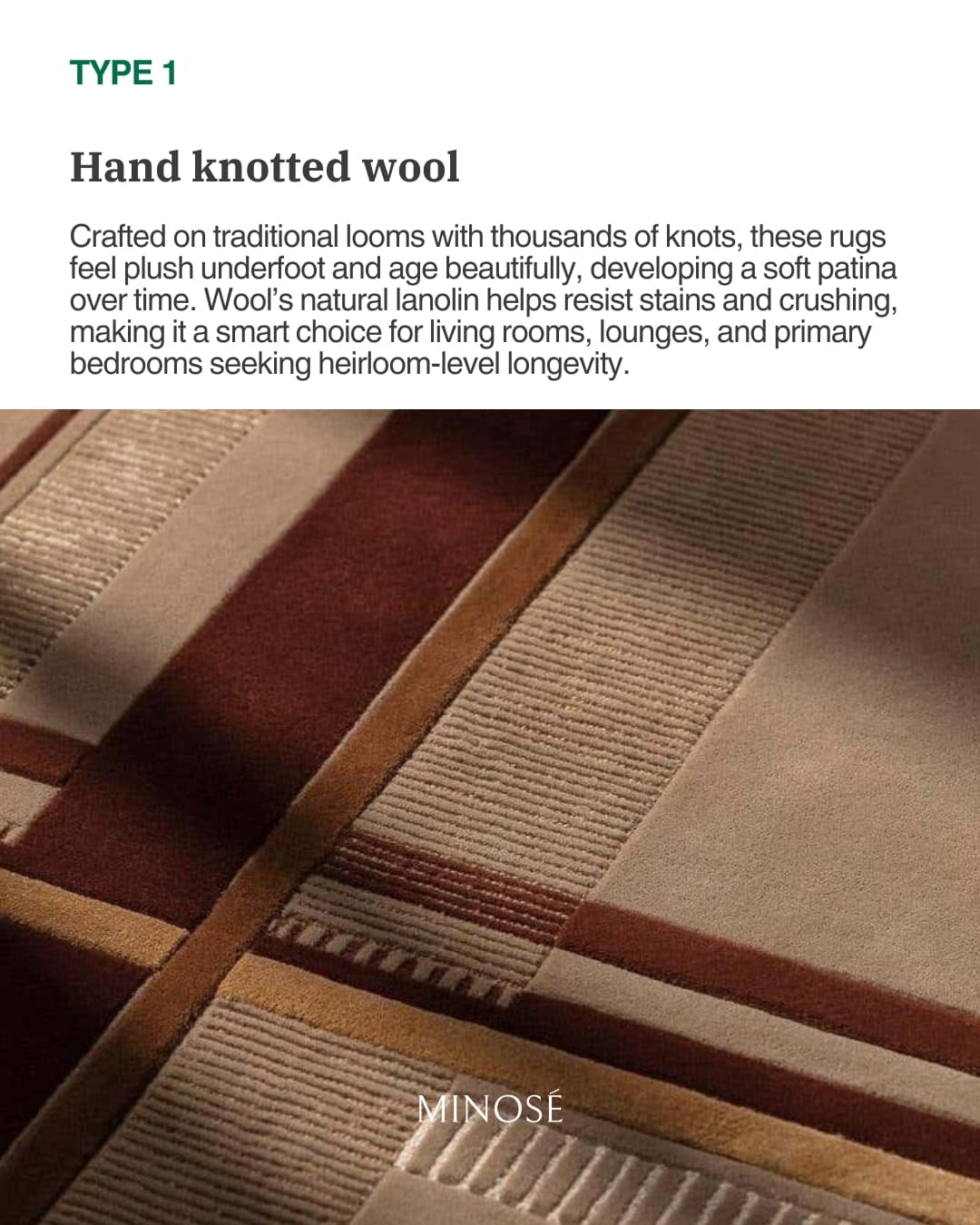
I've seen hand-knotted wool rugs that are decades old and still look remarkable. They don't just survive they improve with age, becoming part of your home's story.
Viscose/Silk Sheen: Liquid Luxury
If hand-knotted wool is the comfortable elegance of a tailored blazer, viscose and silk blends are the glamour of evening wear.
These fibers deliver a luminous, liquid-like sheen that instantly elevates a space with refined, modern glow. When light hits a silk rug, it doesn't just reflect it seems to move across the surface, creating depth and dimension that changes throughout the day. Viscose, often called "art silk," offers similar visual luxury at a more accessible price point while maintaining that coveted sheen.
But there's a trade-off. These fibers are more sensitive to moisture and abrasion than wool, which means they're best reserved for low-traffic zones like formal lounges or bedrooms where they can be properly appreciated. Think of them as statement pieces rather than workhorses they're meant to be admired, spot-cleaned gently, and placed where their beauty can shine without constant wear.
I've specified viscose-silk blend rugs for luxury hotel suites and master bedrooms where the goal is creating that "wow" moment when you first enter the space. They're not for everyone, but in the right setting, nothing else comes close to that refined, modern sophistication.
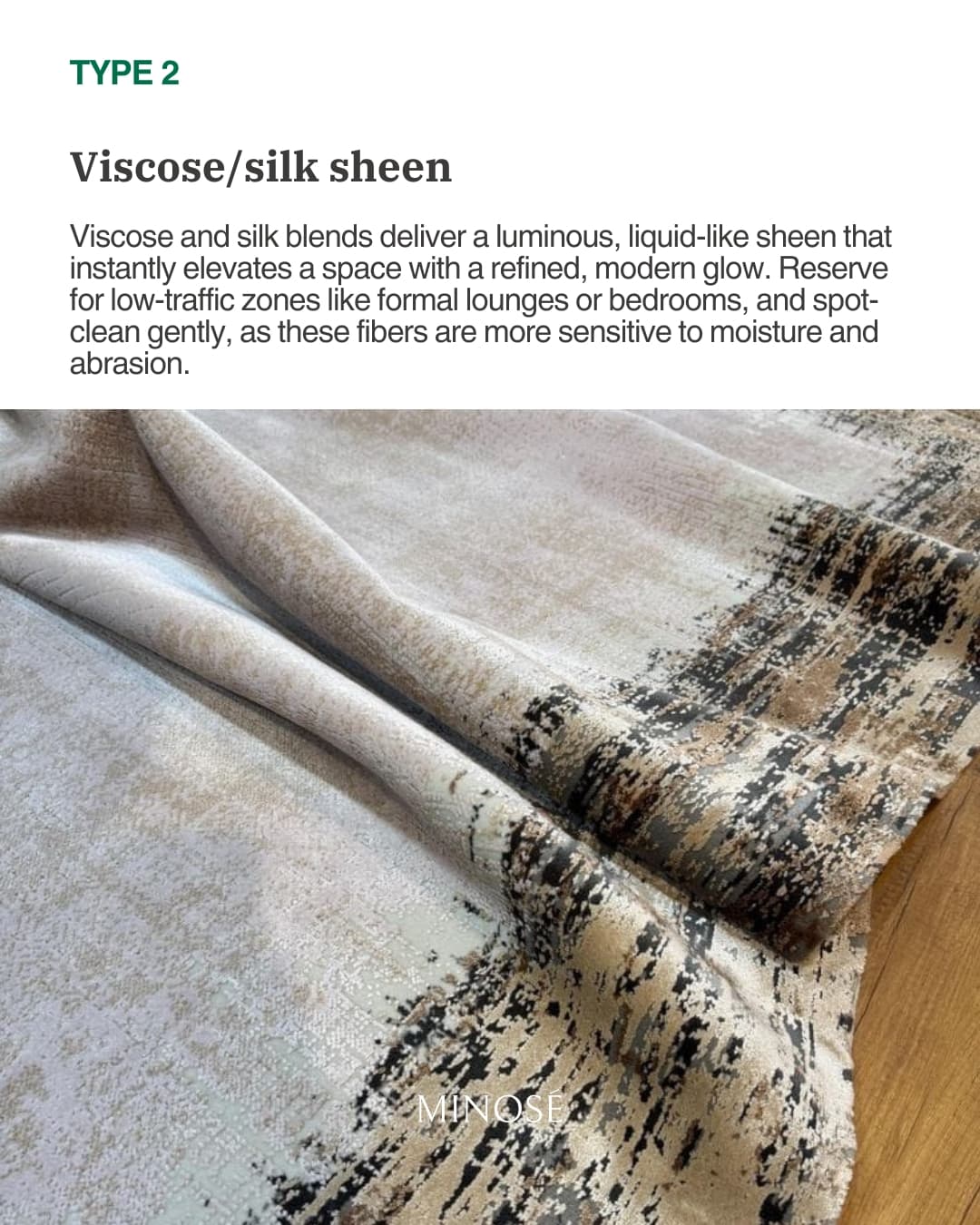
Jute for Texture: Organic Grounding
Sometimes luxury isn't about shine it's about authenticity. Jute rugs bring a chunky, hand-braided look that adds warm, organic texture to spaces that might otherwise feel too polished.
Jute's appeal lies in its honest, tactile quality. It grounds coastal interiors, bohemian spaces, and earthy modern rooms with a natural character that synthetic fibers can't replicate. The fiber has a beautiful matte finish and subtle color variations that create visual interest without pattern.
You can use jute solo for a relaxed, laid-back vibe, or layer it beneath patterned rugs for added dimension and sound absorption. Just keep it away from damp areas natural fibers like jute can absorb moisture and stains more easily than treated synthetics.
What I love about jute is its versatility. It works in minimalist Scandinavian interiors just as well as in maximalist eclectic spaces. It's the great equalizer humble enough not to compete, substantial enough to anchor.
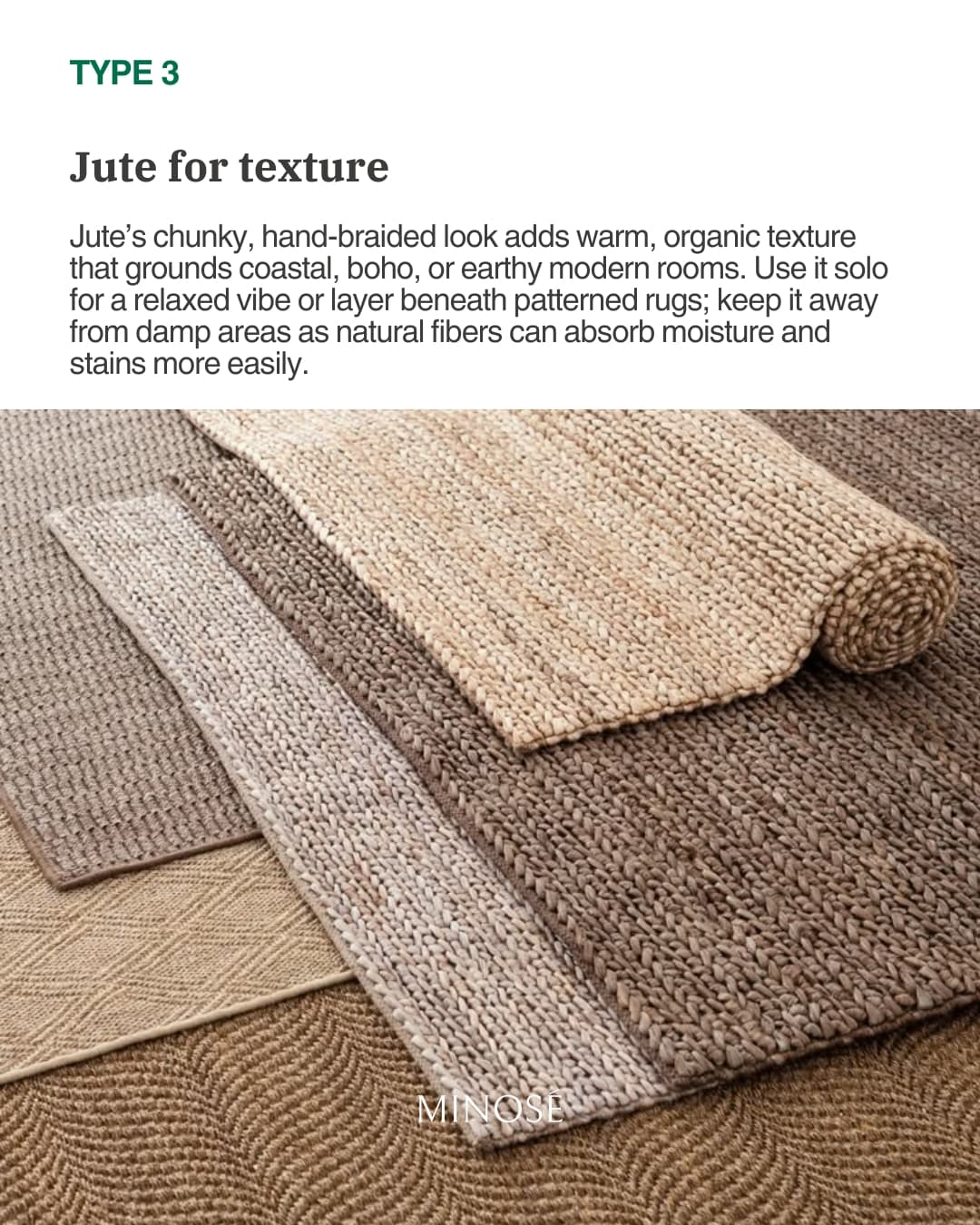
Performance Polypropylene: Smart Luxury
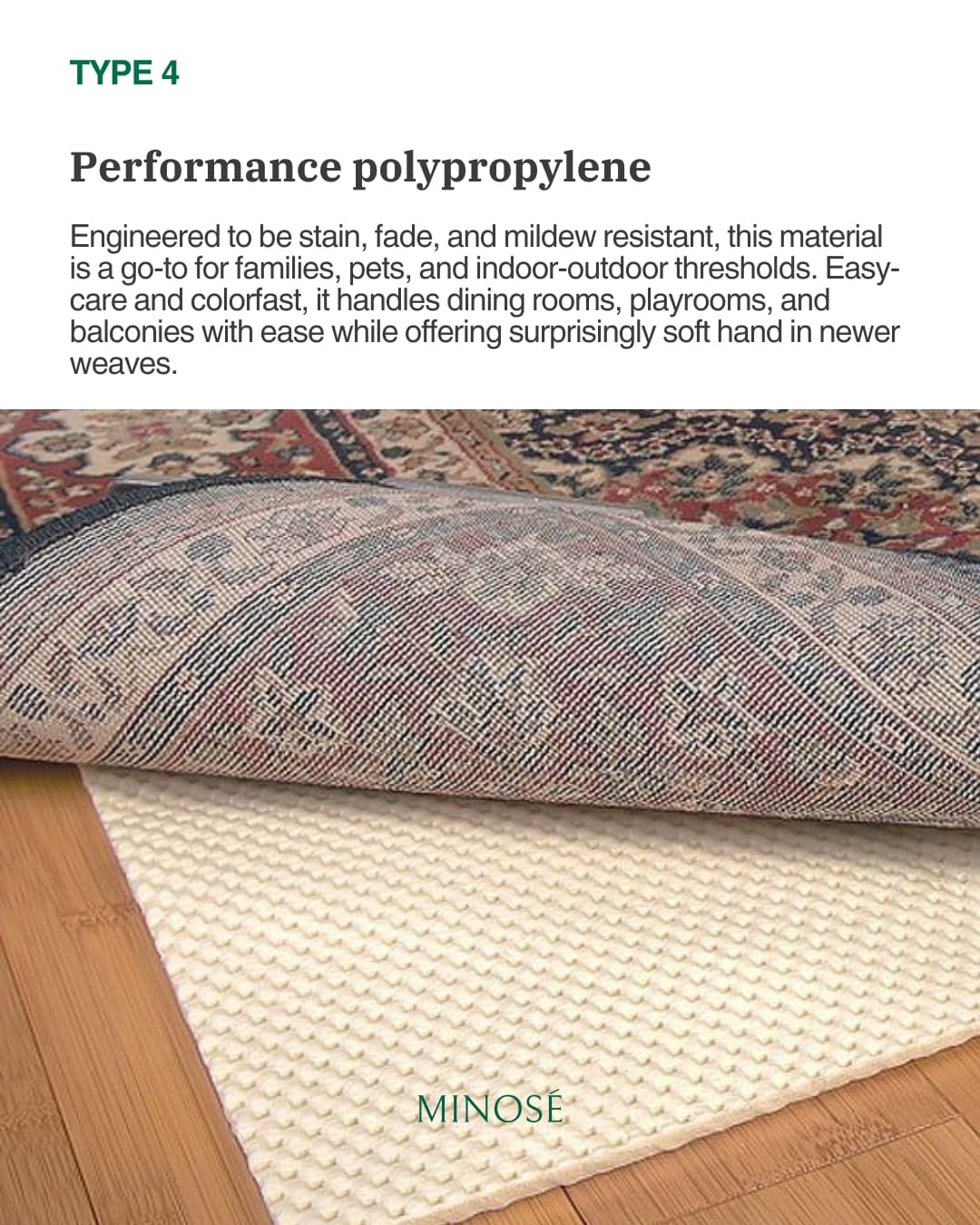
Here's where things get interesting. Performance polypropylene rugs are engineered to be stain, fade, and mildew resistant making them the go-to choice for families, pets, and indoor-outdoor thresholds.
I know what you're thinking: "Polypropylene sounds... industrial." But here's the revelation modern performance rugs have become surprisingly sophisticated. They're easy-care and colorfast, handling dining rooms, playrooms, and balconies with ease while offering surprisingly soft hand-feel in newer weaves.
The real advantage is practicality without sacrifice. You get crisp patterns that stay vibrant even in high-sun areas, and they're simple to shake out or wash when needed. They're lightweight, reversible, and budget-friendly, making them perfect for seasonal refreshes or rental properties where you need durability without major investment.
And because they slide easily under doors and furniture thanks to their low profile, they're ideal for spaces where traditional heavy rugs would be cumbersome. Performance polypropylene has quietly become the smart choice for modern luxury living that doesn't take itself too seriously.
Cotton Flatweave: Versatile Simplicity
Finally, there's the understated elegance of cotton flatweave rugs. These are lightweight, reversible, and showcase crisp patterns with refreshing simplicity.
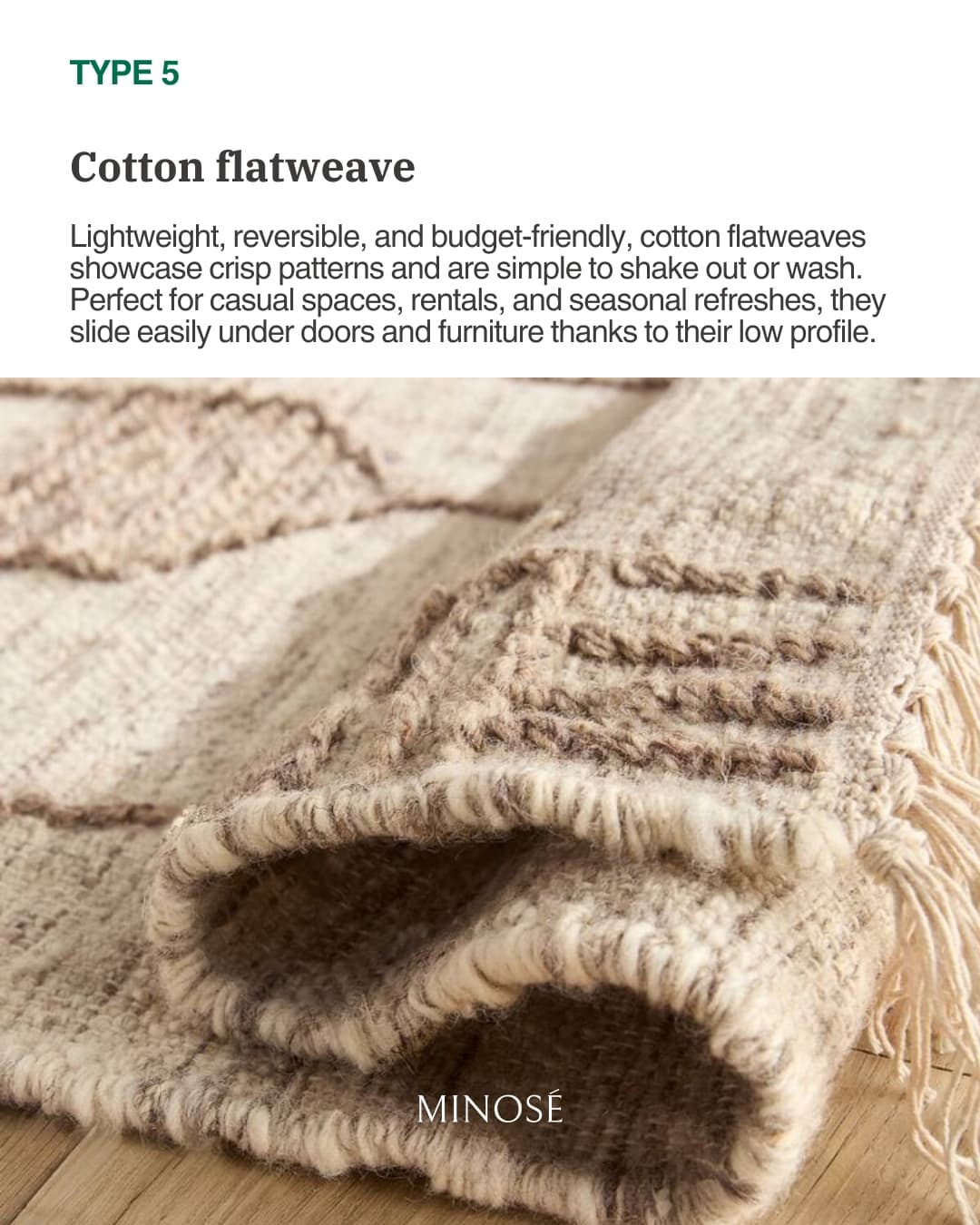
Cotton flatweaves excel in casual spaces, rentals, and seasonal design shifts. They're easy to maintain just shake them out or toss them in the wash and their flat construction means they don't add visual weight to smaller rooms.
Because they're reversible, you essentially get two rugs in one, extending their versatility and lifespan. They're perfect for layering under heavier statement rugs, adding softness without bulk, or as standalone pieces in informal settings like covered patios or breakfast nooks.
What makes cotton flatweaves genuinely appealing is their honesty. They don't pretend to be heirlooms or make grand statements they're functional, approachable, and refreshingly unpretentious.
The Sourcing Advantage
Here's the part most designers won't tell you: where and how you source luxury textiles matters just as much as which material you choose.
At Minose, we've spent over a decade building direct relationships with premium textile manufacturers in Foshan, China where traditional craftsmanship meets modern production capabilities. We're not just connecting you with suppliers; we're providing guided factory tours where you can hand-select materials, meet the artisans, and understand exactly what you're getting.
Every rug that passes through our quality control whether it's a hand-knotted New Zealand wool heirloom or a custom viscose-silk blend for a hotel lobby undergoes multi-stage inspection before it ships. We handle everything: design consultation, manufacturer selection, quality verification, customs clearance, and white-glove delivery to your door.
We're also seeing a major shift toward sustainable luxury in 2025. Clients increasingly want to know where their materials come from, how artisans are treated, and what the environmental impact looks like. That's why we're integrating transparent supply chains and prioritizing manufacturers using renewable fibers, natural dyes, and ethical labor practices.
The rugs we source don't just look beautiful they represent responsible luxury that aligns with evolving values.
Design Trends Shaping 2025
Something fascinating is happening in the rug world right now. We're seeing bold geometric patterns take center stage alongside earthy minimalism. Maximalist designs bursting with color are coexisting beautifully with natural-fiber neutrals.
Oversized rugs are becoming the norm rather than the exception designers are going bigger, using rugs as anchoring statements rather than accent pieces. Sculptural textures that add three-dimensional depth are replacing flat, predictable surfaces. And sustainable materials like bamboo silk, recycled silk, and organic wool are no longer niche they're mainstream expectations.
Whether you're drawn to the timeless elegance of hand-knotted wool, the refined sheen of viscose-silk blends, the organic texture of jute, the smart practicality of performance polypropylene, or the versatile simplicity of cotton flatweave, one thing is clear: the right rug material transforms how a space feels, functions, and ages over time.
It's not just what's underfoot it's the foundation of everything that happens in the room.
